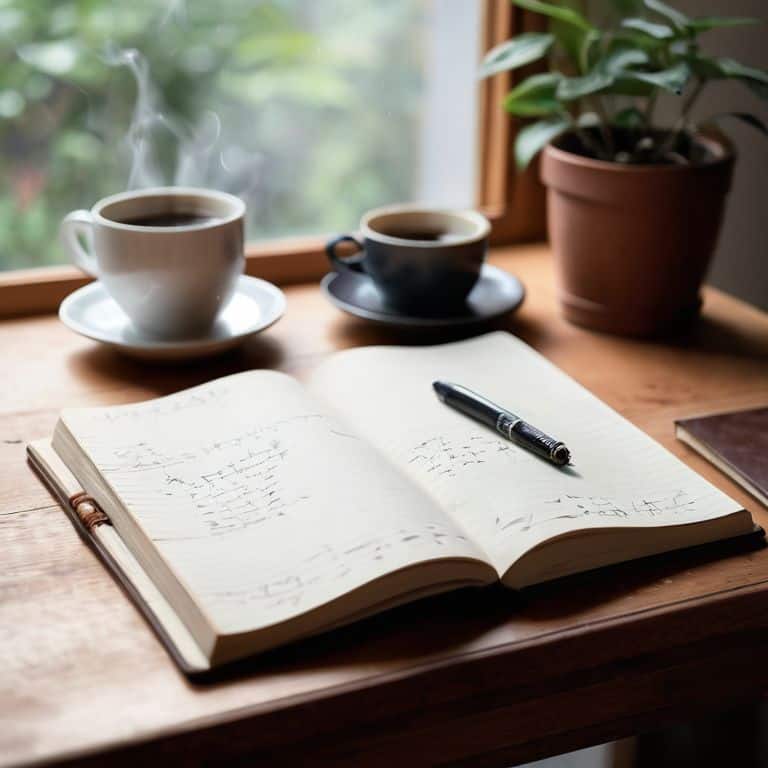I still remember the day I discovered the power of journaling prompts for anxiety. I was feeling overwhelmed, stuck in a cycle of worry and self-doubt, and a friend suggested I try writing down my thoughts. At first, I thought it sounded like a cliché, but desperate for a solution, I gave it a shot. As I began to write, I realized that it wasn’t just about putting pen to paper, but about creating a safe space to process my emotions and gain clarity. I learned that with the right journaling prompts for anxiety, I could calm my mind and uncover a sense of peace I thought was lost forever.
In this guide, I’ll share with you the same practical advice that helped me, and thousands of others, find calm in the midst of chaos. You’ll learn how to use simple yet effective journaling prompts to soothe your anxious heart and develop a journaling practice that brings you joy and peace. I’ll walk you through a step-by-step process to get started, and provide you with actionable tips to make journaling a sustainable part of your self-care routine. By the end of this article, you’ll have the tools and confidence to use journaling prompts for anxiety to improve your mental health and wellbeing.
Table of Contents
Guide Overview: What You'll Need

Total Time: 30 minutes to 1 hour
Estimated Cost: $10 – $20
Difficulty Level: Easy
Tools Required
- Pen (preferably with comfortable grip)
- Pencil (for occasional sketching or erasing)
- Eraser (small, for pencil marks)
Supplies & Materials
- Journal dedicated to anxiety tracking and reflection
- Colored Pens or Pencils (optional, for creative expression)
- Stickers or Washi Tape (optional, for decoration)
Step-by-Step Instructions
- 1. First, let’s start by setting the mood for journaling – find a quiet, comfortable spot where you can sit and reflect without any distractions. This could be a corner in your home, a park, or even a cozy coffee shop. Make sure you have a journal and a pen that feels right in your hand, as this will help you get into the right mindset for writing.
- 2. Next, take a few minutes to breathe deeply and calm your mind. You can do some simple breathing exercises, like inhaling for a count of four, holding your breath for a count of seven, and exhaling for a count of eight. This will help slow down your heart rate and clear your mind, making it easier to focus on your journaling.
- 3. Now, let’s move on to the journaling prompts. Start by writing down things that you’re grateful for today. These can be big things, like supportive friends or family, or small things, like a good cup of coffee or a beautiful sunset. Focusing on what you’re thankful for can help shift your perspective and calm your anxiety.
- 4. For the next step, try to identify your emotions and write about how you’re feeling. Be honest with yourself – what’s causing your anxiety, and how is it affecting your daily life? Writing down your emotions can help you process and release them, and can also give you clarity on what you need to work on.
- 5. The fifth step is to challenge negative thoughts. Look back at what you’ve written so far, and see if there are any negative patterns or thoughts that keep coming up. Challenge these thoughts by asking yourself if they’re really true, and try to reframe them in a more positive or realistic light. This can help you break free from negative thought cycles and develop a more optimistic mindset.
- 6. Next, take some time to imagine your ideal future. What does your life look like when you’re feeling calm and confident? What are your goals and aspirations, and what steps can you take to get there? Writing about your ideal future can help you feel more hopeful and motivated, and can give you a sense of direction and purpose.
- 7. Finally, make a plan to incorporate journaling into your daily routine. This could be as simple as setting aside 10-15 minutes each morning or evening to write in your journal. Consistency is key when it comes to journaling, so try to find a schedule that works for you and stick to it. Remember, the goal is to make journaling a habit, so that it becomes a natural part of your self-care routine.
Soothe Anxiety With Journaling

As we explore the world of mindfulness exercises for stress, it’s essential to remember that journaling is a powerful tool for calming the mind. By incorporating gratitude journaling techniques into our daily routine, we can shift our focus away from anxious thoughts and cultivate a sense of inner peace. This, in turn, can help us develop a more positive mindset and better cope with stressful situations.
When it comes to anxiety relief through writing, consistency is key. Setting aside a few minutes each day for daily reflection prompts for mental health can make a significant difference in our overall well-being. By doing so, we can process our emotions, identify patterns, and gain valuable insights into our thoughts and behaviors. This increased self-awareness can help us overcome negative thoughts and develop more constructive coping mechanisms.
To get the most out of our journaling practice, it’s crucial to establish a comfortable and calming environment. This might involve creating a soothing atmosphere, free from distractions, where we can focus on our self-care routines for anxiety reduction. By combining journaling with other relaxing activities, such as meditation or deep breathing exercises, we can enhance the benefits of our practice and cultivate a deeper sense of relaxation and calm.
Gratitude Practices for Peace
To deepen your mindfulness practice, try incorporating gratitude into your journaling routine. Take a few minutes each day to write down three things you’re thankful for. These can be as simple as a good cup of coffee, a beautiful sunset, or a supportive friend. Reflecting on the positive aspects of your life helps shift your focus away from anxious thoughts.
By focusing on what you’re grateful for, you’ll begin to notice the good things in your life more often. This practice can be a powerful tool in calming your mind and reducing anxiety. Remember, it’s all about progress, not perfection – even small moments of gratitude can make a big difference in how you feel.
Mindful Reflections for Calm
As we delve into mindful reflections, remember that journaling is a personal journey. Take a few deep breaths, and let’s explore prompts that nurture calmness. Consider writing about a serene environment that brings you peace, like a favorite park or a cozy corner in your home. Describe the sights, sounds, and sensations that make you feel grounded.
By focusing on these peaceful scenes, you’ll begin to shift your mindset away from anxious thoughts. Try to dedicate a few minutes each day to this reflective practice, and watch your sense of calm grow. As you write, allow yourself to fully immerse in the experience, and remember, there’s no right or wrong – only your gentle, mindful reflections.
5 Gentle Ways to Get Started with Journaling for Anxiety Relief
- Set a consistent journaling schedule, even if it’s just 5 minutes a day, to help regulate your thoughts and emotions
- Begin with open-ended prompts that allow you to freely express yourself, such as ‘What am I grateful for today?’ or ‘What’s been on my mind lately?’
- Experiment with different journaling techniques, like stream-of-consciousness writing or drawing, to find what works best for you
- Practice self-compassion by writing kind and reassuring messages to yourself, like you would to a close friend
- Keep your journal private and judgment-free, allowing yourself to be honest and vulnerable without fear of criticism or repercussions
Key Takeaways for Calmer Living
Journaling can be a powerful tool to reduce anxiety by providing a safe space for reflection and expression, helping to process emotions and gain clarity
Mindful reflections and gratitude practices can be incorporated into journaling routines to enhance calm and positivity, leading to a more balanced life
By committing to a regular journaling practice with gentle, guided prompts, individuals can develop greater self-awareness, improve their mental health, and cultivate a sense of peace and renewal
Finding Calm in the Pages
Journaling isn’t just about writing down your thoughts, it’s about unwinding the threads of anxiety and gently weaving them into a tapestry of peace, one prompt at a time.
Hannah Jensen
Embracing Serenity: A Journey Through Journaling

As we conclude our exploration of journaling prompts for anxiety, it’s essential to summarize the key takeaways that can help you embark on this transformative journey. We’ve discussed the importance of mindful reflections and gratitude practices in soothing anxiety, and how these simple yet powerful techniques can be incorporated into your daily routine. By committing to a regular journaling practice, you’ll be better equipped to navigate life’s challenges with a clearer mind and a more compassionate heart.
As you close this guide and begin your own journey with journaling, remember that the true power lies not in the prompts themselves, but in your willingness to show up and be gentle with yourself. May your journal become a sanctuary where you can breathe, reflect, and renew your spirit, and may you always find solace in the gentle art of journaling, a reminder that peace and clarity are always within reach.
Frequently Asked Questions
How often should I practice journaling to see a significant reduction in anxiety?
To see a significant reduction in anxiety, I recommend journaling at least 3-4 times a week, with each session lasting around 10-15 minutes. Consistency is key, so try to make it a habit, like right before bed or first thing in the morning. Even small moments of reflection can add up to make a big difference in how you feel.
Can I use journaling prompts if I'm not comfortable writing about my feelings?
Absolutely, journaling prompts can be adapted to your comfort level. If writing about feelings is challenging, start with prompts that focus on observations, gratitudes, or goals, and gradually explore more personal topics when you’re ready. Remember, journaling is about gentle self-discovery, not forced introspection.
Are there any specific journaling techniques that are more effective for anxiety relief than others?
For anxiety relief, I recommend techniques like stream-of-consciousness writing, prompts that focus on the present moment, and reflective writing that explores thoughts and emotions. These methods can help calm your mind and reduce anxiety. Give them a try and see what works best for you!
